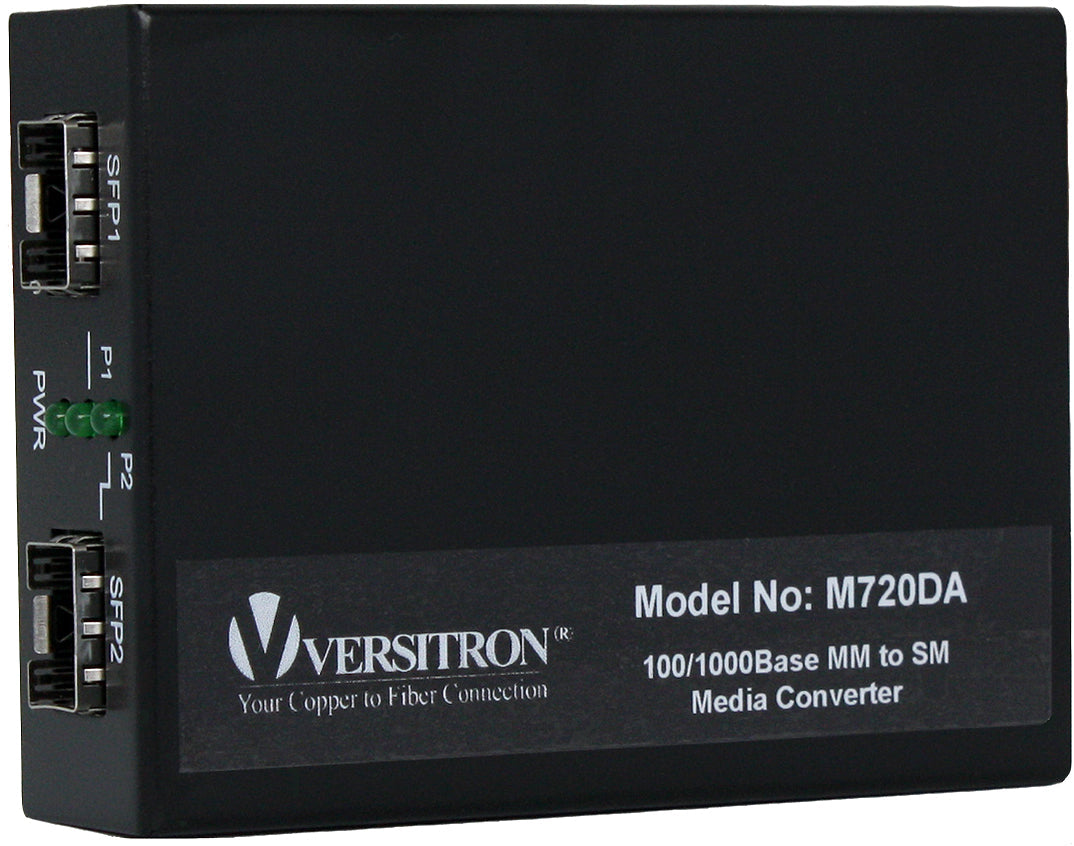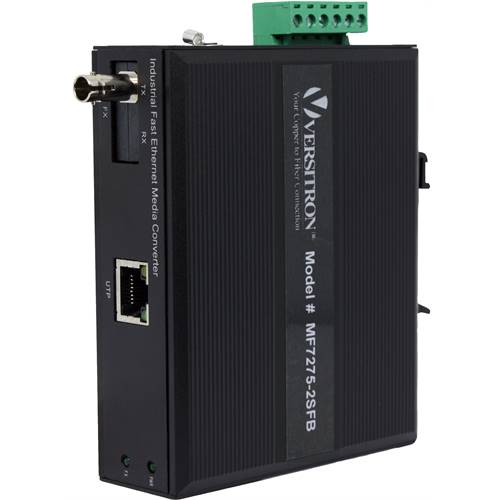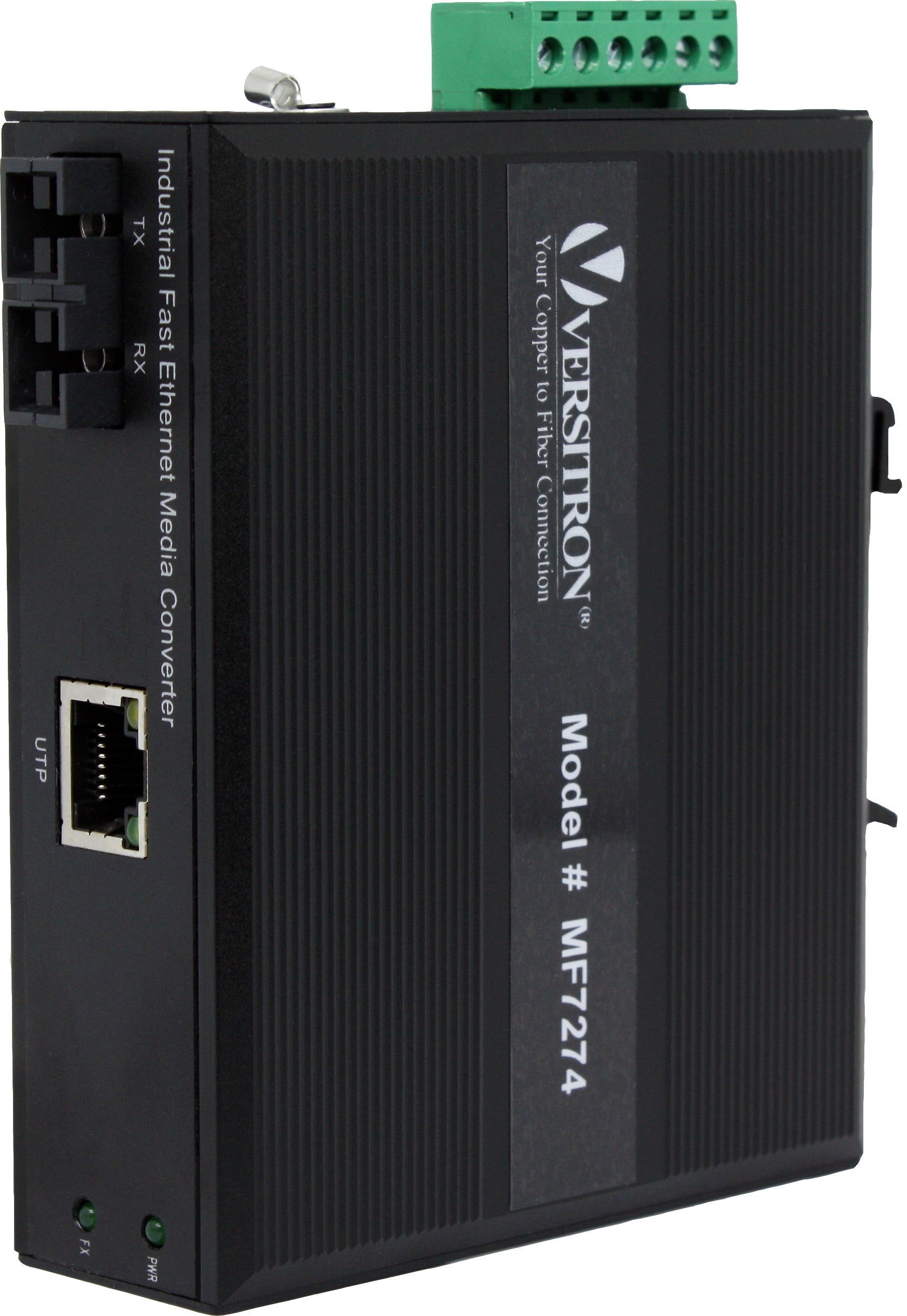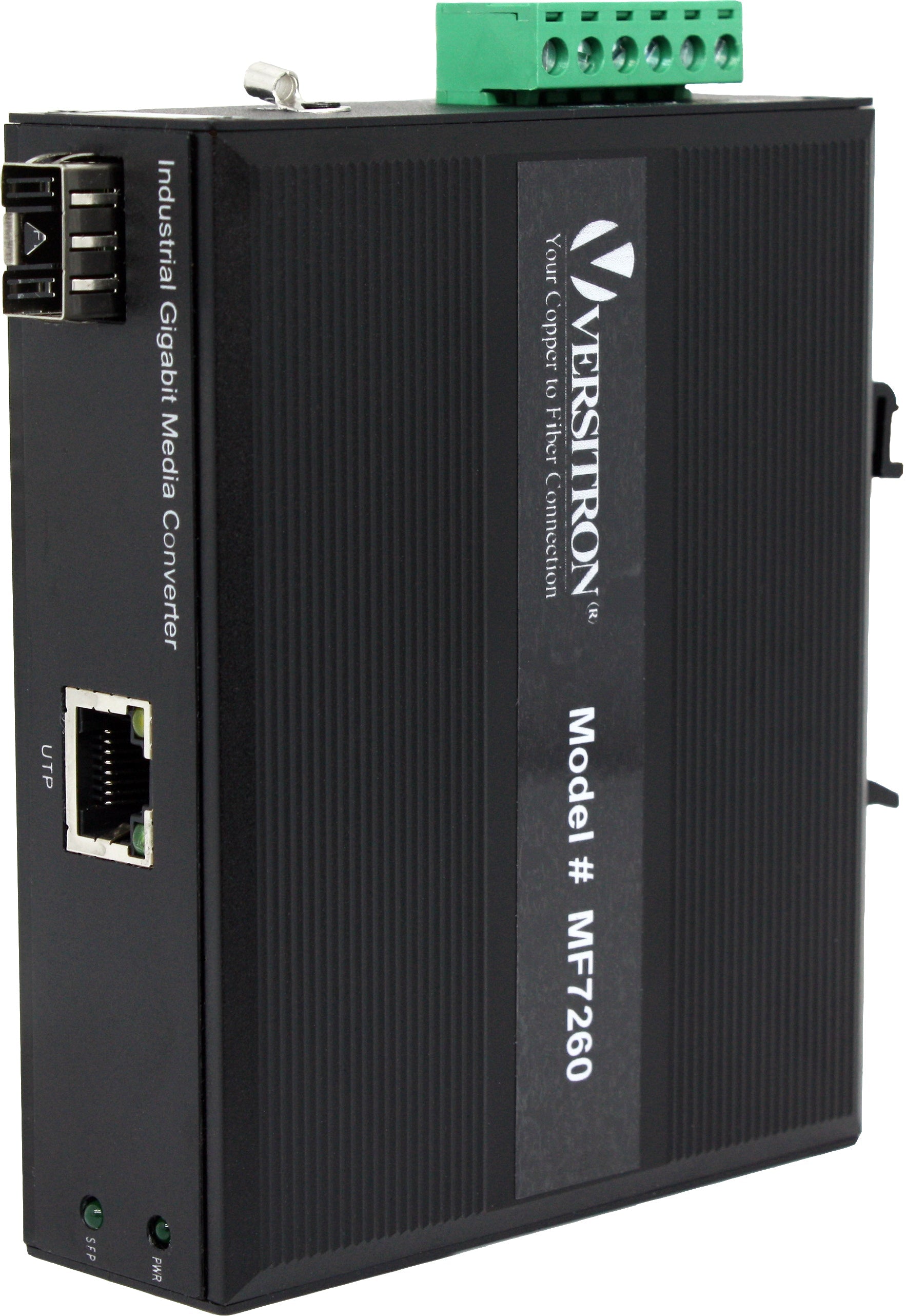
Which are the Different Types of Media Converters?
The following are a few important types of media converters- Standard Media Converters: These are the simplest type of media converters, which are designed without a web interface. Standard media converters are ideal for start-up companies that operate without senior staff and need simple devices.
- PoE Media Converters: These are Power-over-Ethernet technology converters, which provide data and power over a single cable. By doing so, they power the end devices connected to them and also optimize the utility of the Ethernet standard. PoE media converters eliminate the need for additional cables and are widely used in security cameras, IP phones, and wireless access points.
- Enterprise Media Converters: As the name suggests, these media converters are widely used in enterprise network cabling applications. They are used to connect different types of cables or media. These connectors allow businesses to optimize the value of their existing networks by extending their distance, or extending the distance between two similar devices, or extending the life of non-fiber based equipment. They are available in both standard and mini sizes.
- Hardened Media Converters: The networking equipment to be used in climate-controlled equipment features a hard enclosure that is rated to an ingress protection (IP) scale. This construction protects it from temperatures, dust, swigs, and moisture. Hardened media converters enable users to connect different types of cables and media, typically copper to fiber in outdoor environments. These media converters also enable users to optimize the value of their existing network and are suited for industrial applications utilizing fiber cables and driven by EMI noise challenges.
- Carrier Ethernet Media Converters: These media converters are popularly referred by their abbreviation CE media converters. They are mainly used to extend Ethernet to provide Wide Area Network (WAN) connectivity. Carrier Ethernet Media Converters are used to extend network connections or bridge different network types. CE 2 is the latest standard of CE connectors.
- Mini Media Converters: Many times, network managers find it difficult to add network services to non-IT applications like security cameras or in applications where the cabling may not be present. This is where mini media converters can be used. These are simple conversion devices that help create a connection between copper and fiber cabling. These media converters are also ideal for applications with a compact footprint.
What are the Different Forms of Media Converters?
The media converters are available in any of the following forms:
- Chassis: Enterprise networking has transformed over the years. This has brought various changes in the cabling. Some applications like data converters, LAN wiring closets, and switching rooms use many cables, which are terminated at various places to ensure network connectivity. Chassis-based media converters are used for these applications. These media converters support high-density conversion in areas, where flexibility is required to mix and match different types of cables and networks.
- Slide-in Media Converter Cards: These slide-in media converter cards are named so because they are slid into the chassis to ensure flexibility. Slide-in media converter cards draw power from the chassis and they feature egress and ingress ports to meet the needs of the network.
- Standalone Media Converters: The media converters are used to meet the cabling need of non-IT applications. They can be used to connect a remote workstation or an access point that is wireless. Standalone media converters can meet diverse networking requirements. They are equipped with features like auto-MDI/MDIX, auto-negotiation, and an active link pass through. These converters also feature automatic link restoration that enables quick network restoration.
What are Media Converter Extenders and NIDS?
- Extenders: As networking technologies are fast evolving, they demand quick replacements in commercial and industrial environments. Entire replacement of networking cables may be difficult due to the expenses and efforts involved. This is where Ethernet extenders can help. These extenders enable easy conversions from legacy to the latest Ethernet technologies.
- Network Interface Devices (NIDs): Most telecom companies connect their network to the customers’ premises at a demarcation point. Network interface devices (NID) act as demarcation points. They offer demarcation services to users and telecom companies. These services may include circuit protection and testing. NIDs can be availed as chassis-based systems or as stand-alone devices. NIDs also support Ethernet technologies.
What are the types of Media Converter Modes?
Media converters are distinguished into the following types on the basis of transmission:
- Single- Mode Media Converters: They are the media converters that transmit signals in a single direction. The signal is usually the light signals. These converters have core diameters ranging from 9 microns to 125 microns. Owing to such small diameter cores, the signal attenuation is low. This mode is also known as a transverse mode.
- Multi-Mode Media Converters: These converters can transmit data in two or more directions. Multi-mode media converters have core diameters ranging from 50 microns to 125 microns. As the diametrical core is larger than single-mode media converters, the light has high dispersion, as well as attenuation rates. These media converters are ideal for LAN applications, where video streaming takes place. Multi-mode media converters transmit no RF signals.
Singlemode Vs Multimode Media Converter
| Feature | Single-Mode Media Converters | Multimode Media Converters |
|---|---|---|
| Transmission Mode | Use single-mode optical fibers (9/125 µm) | Use multimode optical fibers (50/125 or 62.5/125 µm) |
| Transmission Distance | 20 km to 120 km | 2 km to 5 km |
| Transmission Bandwidth | Greater bandwidth for higher data rates | Relatively smaller bandwidth for lower data rates |
| Application Scenarios | Long-distance, high-bandwidth applications | Short-distance, cost-effective solutions for LANs, industrial environments, educational or retail settings |
| Example Applications | Data centers, MANs, WANs, telecom networks, video surveillance over long ranges | In-house LANs, connecting departments in industrial settings, educational or retail networks |
| Considerations | Suitable for high-speed, long-range scenarios | Budget-friendly, ideal for short-distance networking needs |
| Factors Influencing Transmission | Factors include transmission power, reception sensitivity, and wavelengths utilized | Distance limit influenced by the quality of the fiber and type of transmitted signal |
What are the Types of Conversion?
The media converters support the following types of conversion.
- Copper to Copper: All modern network solutions are designed to support copper cabling and various Ethernet standards. They also help in connecting different Ethernet standards, workgroups, and distant workstations. Enterprises are always finding ways to re-use their installed legacy cables for workgroups or key systems. This is where copper to copper media converters can help. They work as standard converters or extenders. Copper to copper media converters serves as an interface between different network standards. During the interfacing, they may pass the packets between different networks or they may even repeat the signals. Copper to copper media converters enable you to extend the transmission distance, as well as optimize the value of your existing network by reusing it.
- Copper to Fiber: The media converter of this type transforms the electrical pulses used in copper data networks to light pulses in data networks with fiber optics. They enable a seamless integration of fiber and copper cabling networks. Copper to fiber media converters are mostly used to extend network connections that are beyond 100 meters length of traditional copper UTP Ethernet cabling.
- Fiber to Fiber: These media converters ensure connectivity between single-mode (SM) and multimode (MM) and between single-fiber and dual fibers. Fiber-to-fiber media converters are usually independent of any protocol and are used for TDM and Ethernet applications. They facilitate easy conversion of different wavelengths.
Which are the different types of Media Converter Protocols?
Ethernet is one of the most widely used LAN technologies. This type of network generally uses twisted or coaxial cables to transmit network traffic. This standard is most commonly used in wireless networking. Ethernet (10 Mb) is the common type of Ethernet system, which can transmit data at the rate of 10 Mbps/second.
- 10GBase: 10 Gigabit Ethernet (10GbeE) or 10GBase refers to a set of technologies that transmit data at a rate of 10 gigabits per second. 10GBase Ethernet standard largely defines full duplex point-to-point links, rather than half-duplex operations and hubs. This standard was earlier defined by the IEEE 802.3ae-2002 standard. Currently, there are seven 10 Gigabit Ethernet standards for single-mode fibers and multi-mode fiber optical cables. Additionally, there are standards for twin axial, higher unshielded twisted pair copper cables, and category 6 cables.
- Gigabit Ethernet (1000Mb): Gigabit Ethernet (1000Mb) is also referred to as 1 GigE or GbE. Gigabit media converter operates on a this protocol delivers data at the rate of 1 gigabit per second (Gbps). Gigabit Ethernet serves as the backbone of several enterprise networks. The cables and transmitters used for the Ethernet have been around for a long time and are cost-effective, too. This Ethernet standard utilizes point-to-point configuration, where each cable supports two devices on it. Currently, there are five physical standards for Gigabit Ethernet.
- Fast Ethernet (100 Mb): Fast Ethernet (IEEE 802.3u) is a term for technology that assures a maximum data rate of 100 Mbit/s. This standard is an extension of the switched Ethernet standard. The Fast Ethernet over fiber is referred to as 100Base-X. It operates over optical fiber cable or UTP copper cabling. Fast Ethernet was the first standard that was designed to operate a star wired bus topology. There are several Fast Ethernet standards for fiber and copper cables. The standards for fiber include 100Base-LX10, 100Base-BX10, 100Base-SX and 100Base-FX. Some Fast Ethernet standards for copper, includes 100Base-T4, 100Base-TX, 100Base-T2, 100Base-T1 and 100BaseVG.
- Ethernet (10Mb): This refers to the family of computer networking technologies that are mainly used in local area networks (LANs), wide area networks (WANs), and metropolitan area networks (MANs). This standard is defined by IEEE 802.3 standards. This standard was earlier designed to run over coaxial cables. However, now they use fiber optic cables, or twisted pair cables. Starting from 10 Mbps bandwidth, the Ethernet has evolved to support high data transfer rates, as well as long distance networks. Ethernet is mainly used to connect various wired devices together.
- DS3 – T1/E1: DS1 is an abbreviation of Digital Signal 1. It is known as J1 in Japan and E1 in Europe. DS1 is time-division multiplexing (TDM)-based digital circuit-switched WAN service. This standard is used for digital telephone systems in Japan and the United States. It serves as a solution for those applications where users want to extend a couple of DS1 connections over fiber optic cables. At any time, it can transmit up to 24 multiplexed calls of voice and data over the telephone lines. DS1 can support a bandwidth of up to 1.536 Mbs (aggregate). This is a reliable choice when it comes to extending TDM over fiber for establishing connections between buildings. Over the years, it has emerged as a popular technology choice for WAN applications across branch offices.
- DS3 – T3/E3: DS3 is the abbreviation of digital signal level 3 T-carrier. The T-carrier is sometimes known as E3 or T2 in Europe. This carrier has a data transmission rate of 44.736 Mbit/s second or 45 Mb. This circuit is mainly used in telephone carrier networks, where voice channels are active. They can support the equivalent of up to 672 DS0 voice channels. They are also used in enterprises where there is a requirement for high-speed carriers to ensure data service between two offices or multiple offices. In such establishments, they serve as the backbone of high-speed WAN systems.
- POTS: This stands for Plain Old Telephone Service, and it is a voice-grade telephone service. POTS was the first telephone service to utilize analog transmission over copper loops. POT networks usually operate in bi-directional communications in the voiceband frequency, which is 300-3300 Hz. POTS media converters are used to connect voice grade signals between a central office and a POTS equipment using standard telephone signals, which may be placed far from the central office.
- Serial: This is a legacy connectivity solution that has been used or still used to establish a connection between a computer and a peripheral device. Serial communications are widely used for connectivity in medical devices, industrial controls, and automated test systems. These systems use copper 2-wire/telephone cables for connections. There are three most used serial standards – RS 232 that can transmit variable data at 20 kbps up to a maximum length of 15 meters; RS – 422 that can transmit data up to 10 Mbit/seconds up to a maximum cable length of 1,500 meters; and RS-485 that transmits data up to 10 Mbps up to a maximum cable length of 1,200 meters. The data throughout rates decline across all these serial standards, as their transmission standards increase.
- Analog: Analog transmission is the transmission method where information is conveyed using a continuous signal that varies in phase, amplitude, or other properties, in proportion to the information. Analog transmission can be conducted through optical fibers and twisted pair or coaxial cables, and underwater acoustic communication or radio signals.
Managed Vs Unmanaged Media Converters - What is the Difference?
Managed and unmanaged media converters are two important types of media converters. The following points will help you understand it better.
- Managed Media Converters: These are advanced media converters, which possess features such as advanced network monitoring, remote configuration, fault detection, and other functions. They feature Simple Network Management Protocol (SNMP) agent, which reports their performance status to the Network Management System Manager (NSM) manager. The NSM runs on the administrative computer. These media converters are widely used in corporate networks such as RADIUS, TACACS+, LDAP, Kerberos, RSA, and NIS. Managed media converters support SSH, SNMPv3, Telnet, and HTTPS, thereby assuring secure management sessions.
- Unmanaged Media Converters: These media converters enable simple communication between two systems and they are not equipped with advanced features for monitoring or fault detection. Also, you cannot use it for setting up network configurations. Unmanaged media converters are ideal for plug and play or DIY fiber network cable installations. These media converters can be set through a hardware DIP switch.
Types of Media Converters Based on Implementation
Media converters are distinguished into two types depending on their application. All the above-discussed types of media converters belong either of these types.
- Commercial Media Converters: These media converters are suited for data center and office applications, where ambient temperatures are controlled efficiently. They help extend your network distance and optimize the performance of copper-based equipment. These media converters are ideal for environments that are not exposed to harsh conditions.
- Industrial Media Converters: They are designed for harsh environmental conditions. Industrial media converters help convert data between single-mode or multimode fiber optic cables and twisted pair cables. They can withstand temperatures between -40°C to 75°C. Industrial media converters are used in applications like chemical, oil, and gas mining and drilling, as well as building automation.
Related Products Table:
|
Model |
Product Name |
View Details |
|
M7273SB |
10/100 Base TX to 100 Base FX Fiber Optic Media Converter, Multimode ST |
|
|
M7274SB |
10/100 Base TX to 100 Base FX Fiber Optic Media Converter, Multimode SC |
|
|
M7275S-2B |
10/100 Base TX to 100 Base FX Fiber Optic Media Converter, Single-mode SC |
|
|
M7275S-2SFAA |
10/100Base-TX to 100Base-FX Single Fiber Media Converter |
|
|
M7275S-2SFBA |
10/100Base-TX to 100Base-FX Single Fiber Media Converter |
|
|
M7260A |
10/100/1000Base-T to 1000Base-SX/LX "Triple Duty" Gigabit Media Converter with SFP GBIC Technology |
|
|
M720DA |
Multimode to Singlemode | Fiber Optic Media Converter |
|
|
M7260PA2 |
10/100/1000Base-T to 100/1000Base-X PSE Converter | Gigabit Ethernet with PoE+ Technology |
|
|
MF7275-2 |
10/100TX-FX Industrial Media Converter, Singlemode SC |
|
|
MF7274 |
10/100TX-FX Industrial Media Converter, Multimode SC |
|
|
MF7273 |
10/100TX-FX Industrial Media Converter, Multimode ST |
|
|
MF7260 |
10/100/1000Base-T to 1000Base-X Industrial Media Converter |
|
|
MF7260P |
10/100/1000Base-T to 1000Base-X PoE/PoE+ Industrial Media Converter |
|
|
MF7275-2SFA |
10/100TX-FX Industrial Media Converter, Single-fiber, Singlemode SC |
|
|
MF7275-2SFB |
10/100TX-FX Industrial Media Converter, Single-fiber, Singlemode SC |











